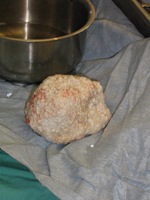Bladder Stones: Tortoises
 Insights into Medical Management
Insights into Medical Management
Bladder stones cannot be dissolved medically like they often are in mammals. Surgical removal is the only treatment.
Most tortoises recover with surgery even if the bladder stone has been present a long time.
Signs
Tortoises may lose their appetite, fail to produce stool, and may become less active. Female tortoises may be unable to lay their eggs. Occasionally, a tortoise may have another presenting problem, such as an upper respiratory infection, along with the bladder stone.
How do you diagnose bladder stones?
Some bladder stone are large enough for a skilled veterinarian to detect by palpating just in front of the hind legs. Some bladder stones can be palpated by inserting a finger in the cloaca. However, radiographs (x-rays) are needed to determine the size and shape of the bladder stone (or stones) and if there are any other complications.
What tortoises are at risk?
In our practice, the Sonoran desert tortoise (Gopherus agassizii)and African spurred tortoise (Geochelone sulcata) account for the majority of cases. Bladder stones have been found in juvenile tortoises under 2 inches in length and adult tortoises weighing over 70 pounds. Any species of tortoise may develop bladder stones.
Why do some tortoises produce bladder stones?
It seems likely that the physiology of desert-adapted tortoises causes them to produce more uric acid as a waste product than other tortoises. Tortoises that do not drink enough water and do not urinate often may be more at risk. There is likely a complicated interaction with diet and water balance that causes some tortoises to have a mix of chemicals in their urine that promotes crystal formation. Also, some organisms, such as some flagellate protozoa, are often found in the urine of tortoises with bladder stones but there is no definitive evidence that these organisms cause the stones.
What will you do with my sick tortoise?
We typically recommend bloodwork, urinalysis, and radiographs to assess the tortoise’s overall health prior to anesthesia and surgery. In some cases, other illnesses may have to be managed before a tortoise can undergo surgery. In rare cases, the bladder stone may be removed by manipulation through the cloaca. Other cases may be removed by an incision in the skin just in front of a hind leg. Most cases require that a portion of the shell is removed temporarily so that the bladder may be accessed. In these cases, an epoxy patch is used to hold the cut shell in place during post-operative healing. The patch will need to be changed several times before the shell is healed. It may take over a year for some tortoises to fully heal. During surgery, we examine the different internal organs and biopsy any that look abnormal. If these tissues are submitted to a pathologist, the knowledge gained may help with long-term management of your tortoise.
What happens after surgery?
Tube-feeding and injectable fluids may be needed for nutritional support and pain relievers may be prescribed to help the tortoise feel better. Some tortoises may need a feeding tube surgically implanted so that they can more easily receive oral medication and nutritional support. Some tortoises may need to be hospitalized for several days until they are passing urine and stool regularly. In some cases a special medicine may be prescribed to help stimulate defecation. Most tortoises will be put on injectable antibiotics. You will need to schedule regular recheck appointments so that your tortoise’s patch can be monitored and changed as needed. At these recheck exams, we often do bloodwork and other lab tests to assess how the tortoise is recovering.
How should I house my sick tortoise?
A sick tortoise should be isolated so it may be carefully monitored. It should be set up in a cage indoors to prevent flies from laying eggs on the wound. It is essential to keep the cage warm. A basking light, typically a 60-100 watt spotlight, should be set-up on one end of the tank. The temperature underneath the spotlight should reach 95-100°F. The cooler end of the cage should be about 15°F cooler. Use an infrared (laser) thermometer to directly measure the temperature of your tortoise. If it spends all its time under the light, the cage may be too cool. If it spends all its time at the cool end of the cage, the basking spot may be too hot. Some source of floor heat, such as a heat tape, is useful for night time heat. Ultraviolet-B light may stimulate healing. ZooMed’s Reptisun 5.0 UV Bulb or 10.0 UV Bulb and T-Rex Active UV Heat are excellent sources of ultraviolet-B light. They should be set up to illuminate the area around the basking light. The Active UV Heat can serve as the basking light. These bulbs need to be replaced every 6-12 months, even if they are still shining, because their ultraviolet output decreases over time. You should make sure your tortoise has a shallow water bowl for drinking. Do not soak your tortoise unless you have checked with us to make sure it is okay.
Closely monitor appetite—when your tortoise begins feeding on its own, its feeding tube may need to be removed. It is also important to monitor urine and fecal output.

